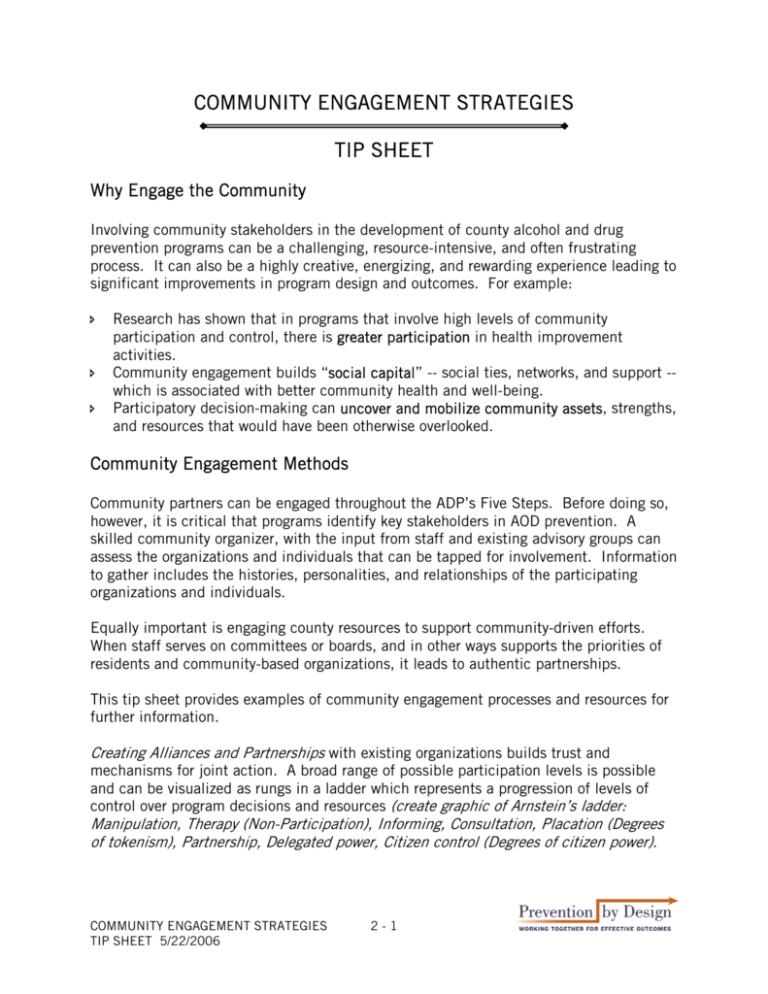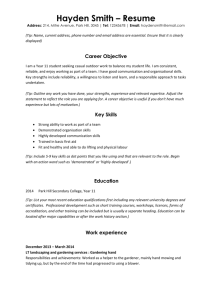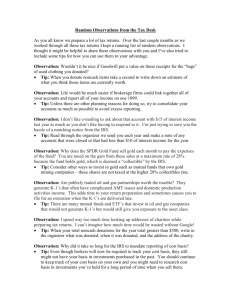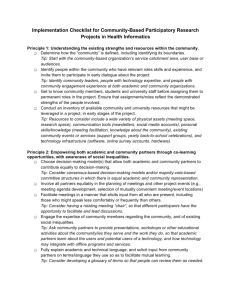COMMUNITY ENGAGEMENT STRATEGIES
advertisement

COMMUNITY ENGAGEMENT STRATEGIES TIP SHEET Why Engage the Community Involving community stakeholders in the development of county alcohol and drug prevention programs can be a challenging, resource-intensive, and often frustrating process. It can also be a highly creative, energizing, and rewarding experience leading to significant improvements in program design and outcomes. For example: Ð Ð Ð Research has shown that in programs that involve high levels of community participation and control, there is greater participation in health improvement activities. Community engagement builds “social capital” -- social ties, networks, and support -which is associated with better community health and well-being. Participatory decision-making can uncover and mobilize community assets, strengths, and resources that would have been otherwise overlooked. Community Engagement Methods Community partners can be engaged throughout the ADP’s Five Steps. Before doing so, however, it is critical that programs identify key stakeholders in AOD prevention. A skilled community organizer, with the input from staff and existing advisory groups can assess the organizations and individuals that can be tapped for involvement. Information to gather includes the histories, personalities, and relationships of the participating organizations and individuals. Equally important is engaging county resources to support community-driven efforts. When staff serves on committees or boards, and in other ways supports the priorities of residents and community-based organizations, it leads to authentic partnerships. This tip sheet provides examples of community engagement processes and resources for further information. Creating Alliances and Partnerships with existing organizations builds trust and mechanisms for joint action. A broad range of possible participation levels is possible and can be visualized as rungs in a ladder which represents a progression of levels of control over program decisions and resources (create graphic of Arnstein’s ladder: Manipulation, Therapy (Non-Participation), Informing, Consultation, Placation (Degrees of tokenism), Partnership, Delegated power, Citizen control (Degrees of citizen power). COMMUNITY ENGAGEMENT STRATEGIES TIP SHEET 5/22/2006 2-1 Asset Mapping is an “action research” process which engages residents in identifying the resources and assets in their communities that can be mobilized to improve health, wellness, and quality of life. Surveying can be done by community stakeholders. There are participatory methods of survey design and administration that take into account local language, culture, literacy levels, and other issues. Geographic Information System (GIS) Maps are electronically drawn maps that show enormous detail in the community by address and geographic area. GIS maps look at variables for health, safety, and social problems and can map those problems by geographic indicators like housing, census groups, community facilities, schools, parks, hospitals, and clinics. Each variable can be overlaid on top of each other electronically so you can take a look at the relationships between these variables to help you focus what you want to do. For example, GIS maps have shown that the density of alcohol outlets is a predictor of higher levels of police problems. As part of a community process, mapping allows you to discover problematic areas and identify strategies such as police action or community-based prevention. This technology can be made accessible to county agencies as well as community groups. (See Resources listed below) Data Mapping: A data map is an inventory of the data sources that inform prevention activities. The map describes where to find data, the kinds of data available, whether the data are available online, the most recent year of data available, the kinds of demographic breakdowns available, etc. (See Data Mapping Tip Sheet, page 1-1.) Town Hall Meetings/Community Forums can be held to gather data and input on needs, assets, priorities, and evaluation. These are typically held when engaging in broadbased community initiatives. Important considerations include: Ð Whether or not you want input from the general public; Ð If potential media coverage would be strategically advantageous at that point in your program development; Ð How you will draw people to your event: what makes it compelling, when you have it, and other access issues. Nominal Group Technique (NGT) is a method of gaining high quality input from a large number of people. See the Designed to Involve link below for detailed information on how it is conducted. Focus Groups are small gatherings of people called together to deal with certain topics or issues. The group size usually ranges between five and ten people and is coordinated by a facilitator as well as a note taker who takes notes and observes the group interaction. Focus groups can be a source of community input that is enhanced by the dialogue among members when asked focused questions. COMMUNITY ENGAGEMENT STRATEGIES TIP SHEET 5/22/2006 2-2 The Logic Model Process is always important to do in partnership with community stakeholders and is an important capacity building experience. (See Logic Model Tip Sheet, page 3-1.) Capacity Building is a critical element for successful collaborative planning. Community partners need to understand how to access, interpret, and analyze data. They need to understand the logic model process and how to develop objectives and outcome measurements in order to identify the most effective strategies for prevention. Participatory Evaluation engages the active involvement of the people whose lives are affected by the issue or program being addressed in every phase of the evaluation process, including problem formulation, defining what data are relevant, selecting methodologies, and interpreting data. It is an approach that engages community members in a joint process that mobilizes and enhances community strengths and problem-solving abilities. Challenges and Pitfalls Because of historical relationships in which residents and other community representatives have felt tokenized, county programs may experience skepticism -particularly if community members look around and see no one else that looks like them. It is critical that broad representation is engaged at the beginning of any planning process. Furthermore, the agency staff’s ability to engage communities in meaningful and culturally appropriate ways is of critical importance. It is valuable to build the capacity of community members to work effectively with systems and agencies; it is equally important for professional staff to recognize the vast wisdom and creativity of their partners who may not operate in the same style, time frames, or language. In addition, the following considerations should be made: Ð Ð Ð Ð Ð There is no holy grail for community involvement. It requires full authenticity and relationship. Anything less, and people go away feeling used. Community engagement takes tremendous time and resources. The benefits far outweigh the costs, but only if it is done with extreme integrity and authenticity. There is a tendency to emerge from a community process with a heavy emphasis on problems. The process needs to be carefully planned and facilitated to ensure it moves into action planning. Agencies need to consider the important advocacy role community partners play. Public employees cannot engage in lobbying or legislative advocacy. There can be the risk of backlash from elected officials if AOD programs are seen as supporting community advocacy. Partnering requires sharing power. This means giving up a certain amount of control. Agency staff members sometime underestimate their ability to do this in a real way. Regulatory or funding mandates often make this extremely tricky. COMMUNITY ENGAGEMENT STRATEGIES TIP SHEET 5/22/2006 2-3 Resources The following websites have excellent resources regarding community processes, including publications, links, and networks. Community Toolbox: http://ctb.ku.edu Asset-Based Community Development Institute: http://www.northwestern.edu/ipr/abcd.html Community Building Resources: http://www.cbr-aimhigh.com/main/ccbam_model_summary.htm National Community Building Network: http://www.ncbn.org/ California Neighborhood Research: http://www.calnr.com Designed to Involve (a site from Scotland, similar to the Community Toolbox): http://www.designedtoinvolve.org.uk/methodologies/home.htm COMMUNITY ENGAGEMENT STRATEGIES TIP SHEET 5/22/2006 2-4







